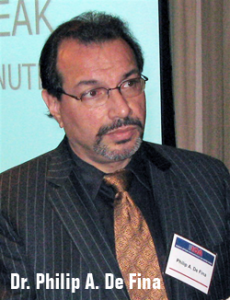Popular Science in their March 2010 Edition published an article entitled “Waking Up the Brain Dead.” the sub-title read “A Cocktail of Therapies Jump-Starts Patients’ Brains.” Then, the May 2010 Ladies Home Journal is publishing an article entitled, “World Leaders in Translational Clinical Research for Alzheimer’s Disease,” (The International Brain Research Foundation – IBRF; in November of 2009, The Clinical Neuropsychologist published an article “The New Neuroscience Frontier: Promoting Neuroplasticity and Brain Repair in Traumatic Brain Injury” that was co-authored by at least two members of the IBRF, Dr. Philip DeFina and his associate Dr. Rosemarie Scolaro Moser, regarding the future of treatment for Traumatic Brain Injury (TBI).
 With an 84% success rate in waking up patients from deep, irreversible, persistent vegetative state comas traditional neurologists, neurosurgeons, and neuroscientists have called these “wake ups” flukes, but once you have nearly 45 flukes, the question becomes, “Are they real?” As the Popular Science article states, Dr. DeFina and his team apply already approved medications, electrical stimulation, and nutraceuticals to the patient, but they do it in a virtual cocktail that has had a dramatic impact on these patients.
With an 84% success rate in waking up patients from deep, irreversible, persistent vegetative state comas traditional neurologists, neurosurgeons, and neuroscientists have called these “wake ups” flukes, but once you have nearly 45 flukes, the question becomes, “Are they real?” As the Popular Science article states, Dr. DeFina and his team apply already approved medications, electrical stimulation, and nutraceuticals to the patient, but they do it in a virtual cocktail that has had a dramatic impact on these patients.
After having spent several days working with the folks at the International Brain Research Foundation, my personal heart strings began making their own music. Not unlike the work that we did at my previous employer, DeFina’s Research Foundation is blazing new trails, not necessarily by inventing all new methodologies, but by applying new approaches to well-established and FDA-approved drugs and protocols. They are making unbelievable progress with highly nuanced protocols that will potentially change neuroscience forever.
In typical “small science” fashion, the traditional approach to these patients has been to apply one protocol at a time, and when that fails, move on to the next. Dr. DeFina appropriately points out that this unconventional approach is effective because it goes to the source of numerous highly complex brain centers. He asked me to imagine the Wright brothers trying to fly an airplane one “part” at a time. “Orville, do you think this propeller will fly?” Of course, that concept is absurd, but that is an appropriate description of how Traumatic Brain Injuries are currently addressed.
 Nearly a dozen years ago, when we were beginning our work at the research institute, it was obvious that the reason that cancer had not been cured was because science takes a very laser-like approach to everything; let’s call it small science. When we determined that we should have a pristine, highly-annotated collection of specially-collected breast tissue, that we should have a central data repository, and that, heaven forbid, we should have ensemble-type multi-disciplinary teams of scientists and MDs working together, it was as if we had suggested that all science be trashed. It was so controversial. To think that one scientist did not keep total and complete control over all of the data generated by his work. It was heresy.
Nearly a dozen years ago, when we were beginning our work at the research institute, it was obvious that the reason that cancer had not been cured was because science takes a very laser-like approach to everything; let’s call it small science. When we determined that we should have a pristine, highly-annotated collection of specially-collected breast tissue, that we should have a central data repository, and that, heaven forbid, we should have ensemble-type multi-disciplinary teams of scientists and MDs working together, it was as if we had suggested that all science be trashed. It was so controversial. To think that one scientist did not keep total and complete control over all of the data generated by his work. It was heresy.
Bottom line? I believe that the International Brain Research Foundation will have us rethinking our living wills not to many years from now as they continue to awaken deep, irreversible coma victims and help them find their lives again. Not unlike the activities at the Windber Research Institute, where the “Platinum Quality Tissue” is currently being used to map the breast genome. We are looking into the future of science, and it is very exciting indeed.
The very difficult news is that the IBRF is totally and completely dependent upon donations and grants for their work, and traditional granting organizations do not favor nontraditional approaches to curing disease and saving lives. So, after you do your due diligence, if you are as moved as I was, check out the IBRF’s website (including their excellent videos) at www.ibrfinc.org, and help them change history.
For further reading:
- Brainline.org: TBI Basics – What is Traumatic Brain Injury?
- DVBIC: Defense and Veterans Brain Injury Center
- NINDS: TBI – Hope Through Research





